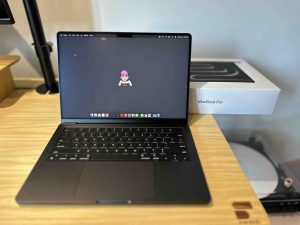
My work revolves around translating innovation into visually stunning layouts and compelling video content. The new MacBook Pro, powered by Apple’s M4 chip, has quickly become an indispensable part of my workflow.
With its seamless performance, groundbreaking features, and integration of Apple Intelligence, this device isn’t just a tool—it’s an extension of my creativity. Let me take you through how it has transformed my tasks in graphic design, video editing, and more.
Designing the print editions and advertorials for NXT Magazine requires a device that can handle heavy files, intricate layouts, and intensive multitasking. The MacBook Pro with the M4 chip excels in every aspect, making Adobe InDesign a dream to work with.
The 14-inch Liquid Retina XDR display offers stunning colour accuracy with a wide P3 colour gamut and a 1,000,000:1 contrast ratio. When I’m perfecting layouts, this display ensures that every hue, shadow, and highlight is rendered with precision. The ProMotion technology, with its 120Hz adaptive refresh rate, makes scrolling through designs and adjusting elements buttery smooth.

Performance-wise, the M4 chip’s 10-core CPU and 10-core GPU ensure that even the most demanding InDesign projects load and respond without delay. Unified memory, configurable up to 32GB, allows me to have InDesign open alongside resource-heavy applications like Photoshop, Illustrator, and Safari, without a hint of lag. File exports—usually a time-consuming task—are lightning-fast, thanks to the optimised Neural Engine, which speeds up image compression and layout rendering.
The keyboard deserves a mention too. Its tactile keys make long hours of layout adjustments comfortable, while Touch ID ensures I can quickly secure my system and get back to work. Combined with macOS Sequoia’s streamlined window management, arranging multiple documents and tools feels intuitive and effortless.
Producing video content for NXT Magazine’s YouTube channel and website demands peak performance, particularly when editing 4K footage. I use Adobe Premiere Pro and CapCut extensively, and the MacBook Pro’s M4 chip has made the editing process incredibly efficient.

With Premiere Pro, rendering timelines and exporting finished projects no longer feel like chores. The hardware-accelerated H.264 and HEVC encoding ensures smooth playback, even when I’m working with multiple layers of effects and transitions. The M4 chip’s second-generation GPU architecture, with dynamic caching and hardware-accelerated ray tracing, delivers up to 2x faster performance compared to previous models. This makes colour grading and effects-heavy sequences a breeze.
CapCut, on the other hand, shines when paired with my iPhone 16. Using the iPhone Mirroring feature in macOS Sequoia, I can seamlessly transfer video clips captured on my phone to the MacBook Pro. The process is instantaneous, and I can even use CapCut directly from the mirrored interface if needed. This integration eliminates the hassle of manual file transfers, allowing me to jump straight into editing.

What truly sets the MacBook Pro apart is its ability to maintain peak performance whether plugged in or running on battery. On long shoots or during travel, the 24-hour battery life ensures I can edit uninterrupted. The quiet operation, thanks to Apple’s efficient cooling system, means I can work in noise-sensitive environments without distraction.
Apple Intelligence, introduced with macOS Sequoia, has revolutionized how I approach both graphic design and video editing. The systemwide Writing Tools are invaluable when brainstorming headlines or crafting text overlays for designs. With a click, I can rewrite, proofread, or summarise content, saving time and mental effort.
For video editing, Apple Intelligence’s image recognition capabilities shine. Searching for specific clips or images within a project is as simple as describing what I’m looking for—“sunset shot” or “city skyline at night”—and the system pinpoints the exact file. This is particularly useful when working on magazine covers or video thumbnails, where precision and speed are critical.

The on-device processing of AI models ensures all this intelligence is private and lightning-fast. Features, like Clean Up in Photos, allow me to quickly remove unwanted elements from shots, while computational enhancements optimise the visual quality of assets before they even hit the editing timeline.
Another standout feature is the ability to manage notifications intelligently. With Reduce Interruptions enabled, only high-priority updates—like an email from the editor—come through during work hours. This helps me stay focused on creating without unnecessary distractions.
The MacBook Pro with the M4 chip is, without a doubt, the most capable device I’ve worked on as an Art Director. Whether I’m crafting intricate layouts in Adobe InDesign, editing cinematic videos in Adobe Premiere Pro and CapCut, or leveraging Apple Intelligence to streamline my workflows, this device delivers on every front.

Its combination of unparalleled display technology, raw processing power, and thoughtful features like iPhone Mirroring and systemwide AI tools make it an essential tool for creatives.
Apple has raised the bar yet again, and I can confidently say this: if you’re a professional in need of a machine that keeps pace with your imagination, the MacBook Pro with the M4 chip is the only choice.
The Apple Macbook Pro retails from SGD 2,199 and click here to find out more.






